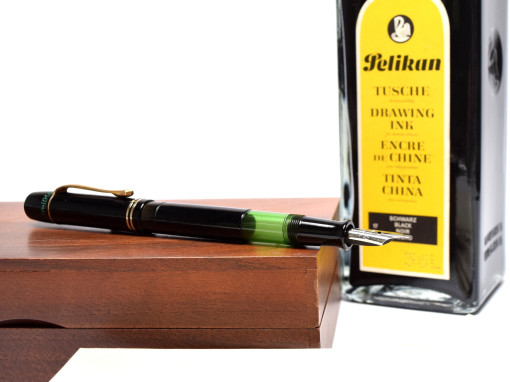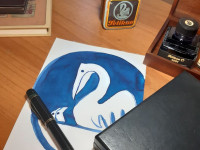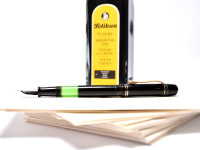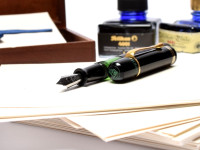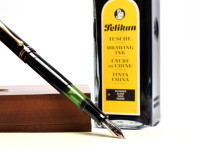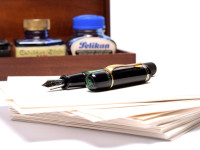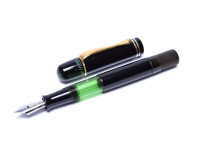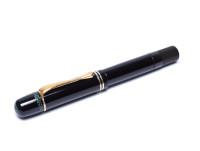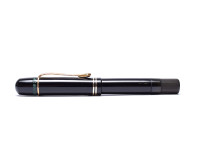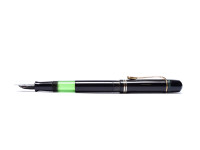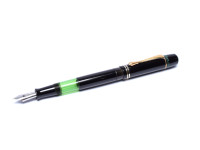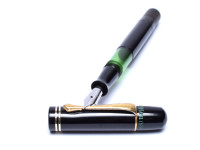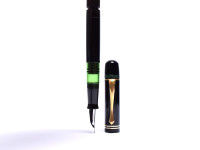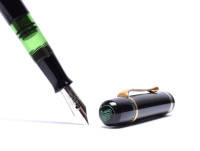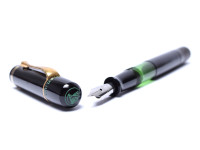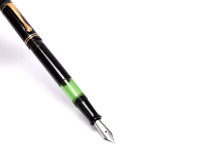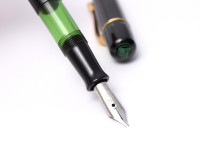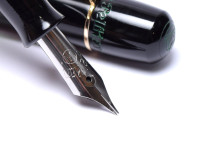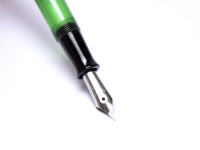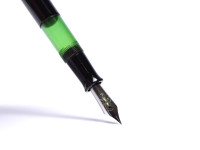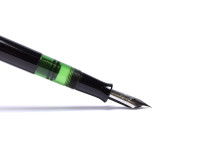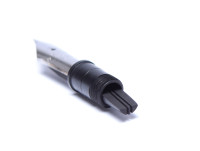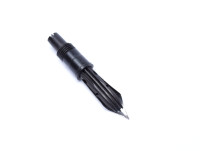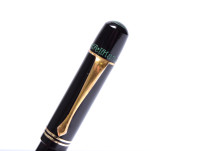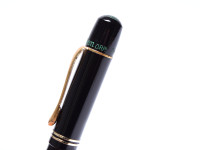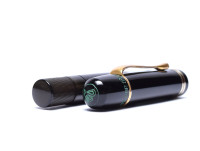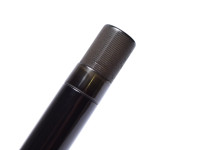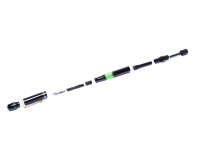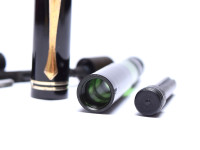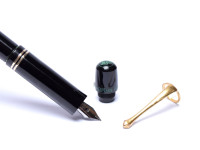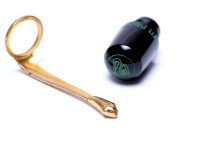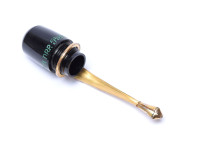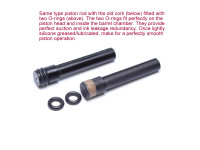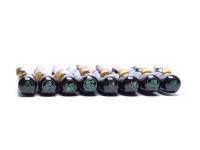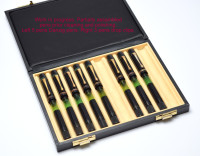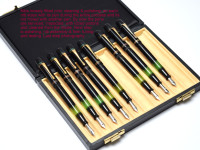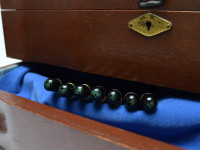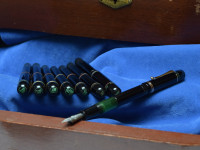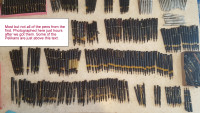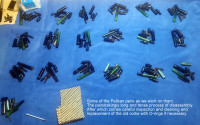Details
Pelikan 100 Black - Danzig Clip
Manufacturer/Model: Pelikan Germany/100 All Black - Danzig Clip
Year of production: Exact year unknown, somewhere between 1937 and 1940
Filling system: Piston filling (New x2 O-rings installed in place of the original cork - see photos)
Nib: CN - Chromium Nickel - EF Extra Extra Fine Super Flex melts on paper, writes up to BB/3B, super wet and consistent; Original Ebonite feed with 3 long vertical fins in Ebonite collar
Material: Cap, Captop, Front Grip Section & Barrel sleeve - celluloid. Turning Knob and Piston Assembly - Ebonite/Hard Rubber. Barrel either celluloid or acrylic, most likely celluloid. Gold Plated clip and rings, Danzig Diamond Clip
Length (pen closed): 117.2mm, 160mm posed; Diameter at cap 12.8mm; Diameter at barrel ink window 10.8mm; Diameter at barrel sleeve 11.8mm; Cap length with captop and clip 61.2mm; Barrel length without nib with t.knob 94mm, Clip length 37mm
Condition and information:
*Date first published & listed: June 15th 2021
You can see a video and writing sample of this pen here:
https://www.youtube.com/watch?v=WdggpX2YNhA
Context & Provenance:
To read more about the circumstances about how and where this pen was found, please visit our blog page here:
https://www.protopens.com/blog
The Black Danzig Pelikan 100s:
The pen offered in this listing and pictured above, is one out of 33 Pelikan 100 and 100N pens in this find. Out of these 33 Pelikans there are 18 Pelikan 100 among which 8 Pelikan 100 All Black with green and green to yellowish barrels, pens with the cork piston filling system, (there are a couple of photos of this group in the pen tray). Out of these 8 identical pens, 5 pens are with the so-called "Danzig" diamond clip, while the other 3 are with the standard shape "drop" clip resembling the Pelikan peek. This pen is one of those 5 Danzig pens. The Danzig clip pens are probably one of the Pelikan pens most shrouded in mystery, as it is still not clearly understood if they were made in Gdansk (Danzig in German), or were they simply made in Hanover but with a different Diamond shaped clip tip.
There are many theories and debates around these pens, a simple google search can take you deep into the Danzig rabbit hole. Here at ProtoPens we are not able to determine if these Danzig pens had come from another factory or not. We have theories and observations that go either way, but we are far away from coming to any conclusions, as this is a subject which is extremely deep to uncover with certainty. We will probably write a lengthy blog post with our observations about these pens, again without drawing any conclusions as to the origins of these pens, however in that blog post we will clearly explain all of our observations, as we simply had a large sample of pens from the same find, both Danzig and standard clip pens, and we will compare and explain both, knowing that all of the 33 pens came from the same shop 80 years ago. Furthermore, out of these 33 Pelikans in this find, only these 5 Pelikan 100 all black have the Danzig clip, while none of the 15 100N pens had the Danzig clip. Again, here same as with the regular clip 100 Black pens, these Danzig pens have two different inscriptions on the captops, some have "Pelikan Patent" some have "Pelikan D.R.P.". The pen in this listing has the "Pelikan PATENT" inscription on the captop.
*The build, the performance, the nib and the appearance of these 5 Danzig pens, (besides the shape of their clip), is identical to the 3 Pelikan All Black pens with the standard clip which were listed earlier, so the text below is nearly identical to that listing with some minor changes which are applicable to these pens only:
...Now, you have probably noticed the wide array of years in the title, starting from 1937 to 1940, (possibly even made before 1942), which some of you collectors consider a true heresy for us not to be able to pinpoint the exact year and sometimes even the month of production, and indeed you are right, it is a heresy. However when it comes to these 100s and especially about these war models, and especially in these transitional models, and especially when records were vaguely kept and almost entirely destroyed in WWII, there are probably only a handful of people in the world, maybe even less, that will know exactly what year this pen was made and what exactly is going on with these pens and why there are some inconsistencies with the Pelikan pen (pens that will be offered here), why we are not able to determine the exact year, and why some "known facts" don't seem to fit on some of these Pelikan pens.
To begin with, even though this is a 100 and not the 100N model, this one comes with a CN nib, which was not entirely not heard of, as even if it preceded the 100N, eventually the 100 and the 100N were produced in parallel for 1-2 years. First the 100N was only produced for export, and was often exported together with the 100, while in Germany only the 100 was offered for 1-2 more years.
Even though this pen has the entire piston made out of ebonite, and its cork is an actual cork, it does not necessarily correspond with the cap, captop and section being made out of celluloid. The sleeve is also celluloid. (We fit the sleeves back with just a touch of a silicone grease underneath them. Since there was little to no shrinkage in the pens this is possible and instead of using any kind of glue, including shellac, the best way to keep the sleeves safely on the barrels is basically just by a touch of silicone grease. With this way any possible repair in the future will be extremely easier as there are no glued parts to deal with, the pen is simply easily disassemblable by hand). Usually the pens from this era had a hard rubber/ebonite cap, captop and even a section. Furthermore, the barrel is the two part barrel, celluloid grip section and very likely transparent celluloid barrel. Even though we have tested the pens, we cannot quite determine if the barrel is a transparent celluloid or is it actually early acrylic introduced just a couple of years later, however it's certainly not the injection molded one-part barrel-section (with the transparent section) as these are obviously two separate parts.
To add to the intrigue, the pen is fitted with a CN nib, which would suggest a pen made or at least assembled by Pelikan in late 1939 to early 1940 when the prohibition of gold use in pens started. Or maybe that the shopkeeper did the swap during the war 1940-41-42 in order to stay in business. Needless to say, some of these pens raise more questions than they answer. We can only present the facts and the pens as we have them, but we are certainly not any of those handful of people which can shed more light to these pens.
From what our experience and research tells us, these 5 Danzig pens are transitional models using components from several phases of the 100 model development, what the people which are deep in the Pelikan rabbit hole call the 6th generation 100, made somewhere in between 1937 and 1938, but fitted with the CN nibs maybe in 1939 or 1942. To make things even more mysterious, in this find we have absolutely identical pens to these ones, mixed with both standard clips and Danzig clips. This would suggest that at the time, you can buy this exact pen from this shop either with a Danzig or the Standard clip.
Please examine all of the photos closely and draw some professional dating conclusions yourselves. Please also feel free to ask for additional photos including from some obscure details of the pen, or ask anything you deem necessary. If knowing and willing, please share any information which you deem needs correcting or simply adds to this knowledge and we will cite it here so other people can read it and enjoy it too.
This pen:
The pen offered here as most from this collection is a museum-worthy Pelikan 100 All Black Danzig fountain pen, presumably made between 1937 and 1940. The Pelikan 100 was the first piston fountain pen with a differential piston filling system, invented by the Hungarian engineer Theodor Kovacs in 1925, after which he sold the patent to Pelikan and made the Pelikan 100 possible. The differential piston system we know and still use today, is based on this one, the rest is history.
Early Pelikan celluloid pens are virtually unmatched by any pen manufacturer in any era, they are simply breathtakingly beautiful objects with such a deep patina, shine, gloss and most unique patterns for the color celluloids, they are simply works of art. The Pelikan 100 embodies the Bauhaus design where form follows function, and to this day, it is still one of the most comfortable pens to hold and use, simply fits in the hand, has a perfect balance and thickness, has a natural warmth and feel in the hand, it simply belongs.
Pelikan, starting in 1929 marketed these pens as the first transparent pens, where the ink level can be easily read and easily refilled with the piston action when the ink was going low. In addition they proudly marketed the pen as an astonishing technical advance in writing, which couldn't be more true as we still use the same filling and writing principles today. Another nice feature is the 4 thread spiral on the cap and on the barrel; no matter where the starting position is when the user starts to screws or unscrews the cap, the cap will be screwed/unscrewed all the way to close or open the pen on in only 1-1.25 rotations. These are just some of the details that make these vintage Pelikan pens so special.
Most amazingly however is the pen's condition. The pen has no cracks, scratches, dings, chips or teeth marks, no deformations, discoloring, it is simply a time capsule as it was made months and not 80 years ago. The pen is in perfect working order. Made with about 18 parts, this is a masterpiece of precision engineering, hard to believe that it was made 80 years ago. All parts on this pen are its original, the only part replaced is the cork. We have fitted the pen with x2 new rubber O-rings which replace the old cork, the only part on this pen that ages and needs to be replaced. Even though these old corks can sometimes work flawlessly, they will eventually start to make squeaking sound when moving the piston if they are dry, but if the pen is used regularly they will work just fine. However, to be on the safe side and also to be able to fully stand behind our Warranty, we decided that changing the cork is the best way to ensure the pen performs optimally for years. The piston is now super smooth, easy to turn and fills all the way to the top and will work flawlessly for decades. There is that amazing barrel clarity rarely seen on these old 100s, a lovely bright green ink window. The inscription on the captop is nice and crisp, inscribed twice in a row, "Pelikan D.R.P." which stands for Deutsches Republic Patent. The rings are tightly fit to the cap that suggests there is no shrinkage or deformations. There is some brassing on the clip due to some minor corrosion, but this is easily repairable and can be re-gold plated by us or any jeweler around the world. However in order to keep it authentic we will not perform any gold plating on the pens from this find, including this one. Interesting thing to point out is that these Danzig clips showed less corrosion and blemishing than some of the standard clips in this find, and when shipped to you, after they are polished, they will look almost like new.
One of the best things about this pen is of course its nib. This is the epiphany of nib making. The nib is fully flexible, EF precise and sharp CN nib which stands for Chromium-Nickel, with a crest above the breathing hole. The crest was meant to give the tines more movement and make the nib more flexible. However some pens have the identical nib with the same font and markings but lack the crest, but still they are flexible as any other nib with the crest. There were some marks on some nibs, like one or two dots on some nibs, or a triangle or a line or two lines on other nibs. The true purpose of these markings is beyond our knowledge, but we know it is not the nib size as they are all the same size. They are all super flexible F and EF nibs. We believe these marks on some nibs may represent some way of Pelikan keeping track of who was the metal strip supplier for that particular nib batch or some other nuances that would make them keep track of these nibs easier. The CN nibs were the successors of the Pd nibs which came after the prohibition of gold for non essential use during WWII. The idea was that since this alloy didn't rust and was also flexible, it would provide the same feeling and writing experience as the gold nib. In most respects they were right, and it did, superbly. This is a truly super flexible nib that simply melts on the paper. It will write any size from EF up to double broad or even wider. Since its a EF its a super sharp, tends to be slightly scratchy, however this is common on such sharp nibs and should go away if the pen is used regularly, i.e. it will smoothen and adapt to the strokes and angles of its user. We can try to smoothen the nibs, however knowing that these nibs were not used, we believe that is a decision you should make once the pen is with you, as the nib may smoothen to your liking fairly easily. If on the other hand we smoothen the nib, we may irreversibly damage it or bring it to a state which was not intended by the manufacturer when originally sold, i.e. it would be like fixing a new car. The nib is fed by its original ebonite feed with 3 vertical fins/radiators and sharply tapered at the back end. This feed tapering provides kind of pre-ink reservoir behind it, essentially creating a pre-ink chamber, where the entire weight of the ink reservoir is directly transferred to the ink canals of the feed but it also helps for the capillary action to be able to suck up the last few drops of ink in the barrel. This feed has a very large ink canal allowing for constant ink flow, making the nib quite wet. The imprints are super clear and parts are still filled with the green filling originally done on this pen. The finely grooved/knurled ebonite turning knob feels nice and provides the needed grip when filling the pen.
It's not by chance that the 100 is one of the most appreciated, most collected and most admired pens in the world. Having the pleasure of working with so many of these pens, one understands why this is. It's just amazing the precision with which these pens were crafted, the ebonite/hard rubber differential piston mechanism is so well engineered, the entire pen disassembles like a true mechanical machinery, no glue was used in the original assembly, no lubricants were used, all parts are threaded or friction fitted. The form, shape and size were spot on from the day it was conceived, and they still are to this day, it just felt so right in the hand, the weight and the ergonomics, basically perfect.
These Pelikan 100s are more than just pens, they are engineering and design timeless masterpieces.
*Please feel free to contact us if you need any additional information or if you'd like to add or comment on this description.
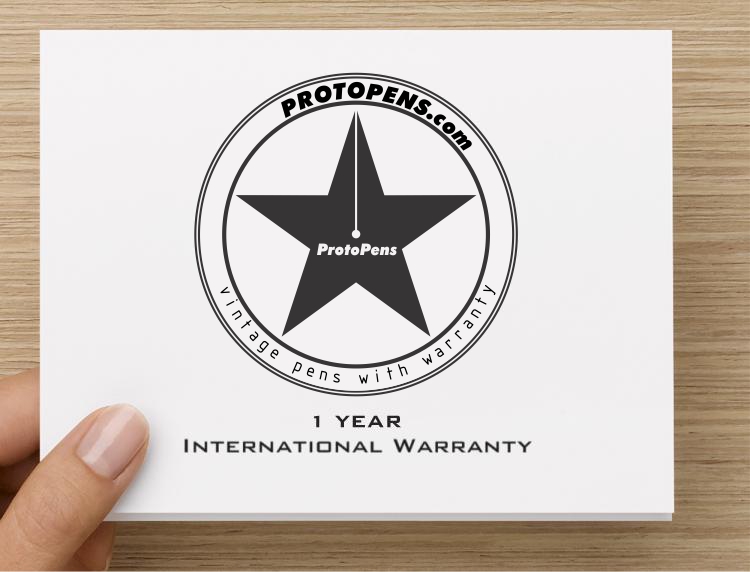
This item is covered by our 1 Year Full International Warranty at no additional cost. The terms of our Warranty are very simple, meant to give you a secure and trouble-free buying experience.
-
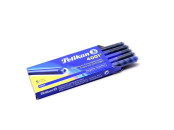
New Made in Germany PELIKAN 4001 Standard International Format Giant Large Size Royal Blue (Königsblau) Fountain Pen Ink Cartridges - Pack of 5
$4.95 -

Original Genuine Montblanc No.10019 (Art No 16120) Twist Action Fountain Pen Piston Converter in Box
Regular Price: $24.99
Special Price $15.95
-
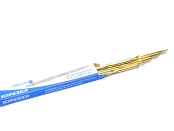
BLUE Schneider 575 / Express 75 Office Ballpoint Ball Pen Metal Slim Refill ISO 12757-2 A2 F Fine Size Made in Germany (Fits Most Vintage Pens)
$1.99 -
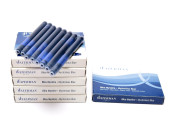
New WATERMAN Paris Standard International Format Made in France Mysterious Blue Black Large Size Fountain Pen Ink Cartridges Refills - Pack of 8
$6.95 - More Ink & Refills ...
-
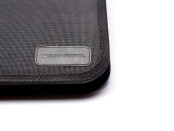
Rare Sanford 36 Slots High Quality Black Hardcover Zipper Pouch Case Holder/Folder Made in U.S.A by COLOMBIA TWO INC Portland Oregon
Regular Price: $199.99
Special Price $58.99
-
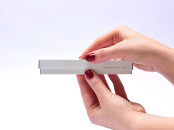
Pack of 5 ProtoPens Vintage Style Safe Keeping Storage Shipping and Organizing Fountain Ballpoint Pencil Pen Case Box
$8.99 -
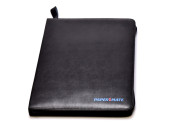
Rare Paper Mate 48 / 52 Slots High Quality Black Leatherette Zipper Pouch Fountain Ballpoint Pen Pencil Case Holder/Folder
Regular Price: $149.99
Special Price $89.99
- More Cases ...
This item is located in Europe and ships Worldwide.
At checkout you can choose between two shipping options:
$12.95 Regular Postal Service, Priority & Registered Airmail - Limited Tracking 1-4 WEEKS Delivery
$48.95 DHL Express International - Accurate Tracking 1-4 DAYS Delivery Worldwide
Learn more about these shipping options.
Prior shipping our items have to pass our highest quality control inspection, are perfectly cleaned and tested by ProtoPens pen staff after which are carefully packed. If the pen does not come in its original manufacturers box, it is packed in a special ProtoPens case.
RETURS: Returns are accepted. You are welcome to ship the item back to us within 7 days after receiving it in the same condition it was delivered to you and we will issue you a full refund! Learn more...
(NOTE: If you don’t receive an email from us soon, please check your email spam folder)


